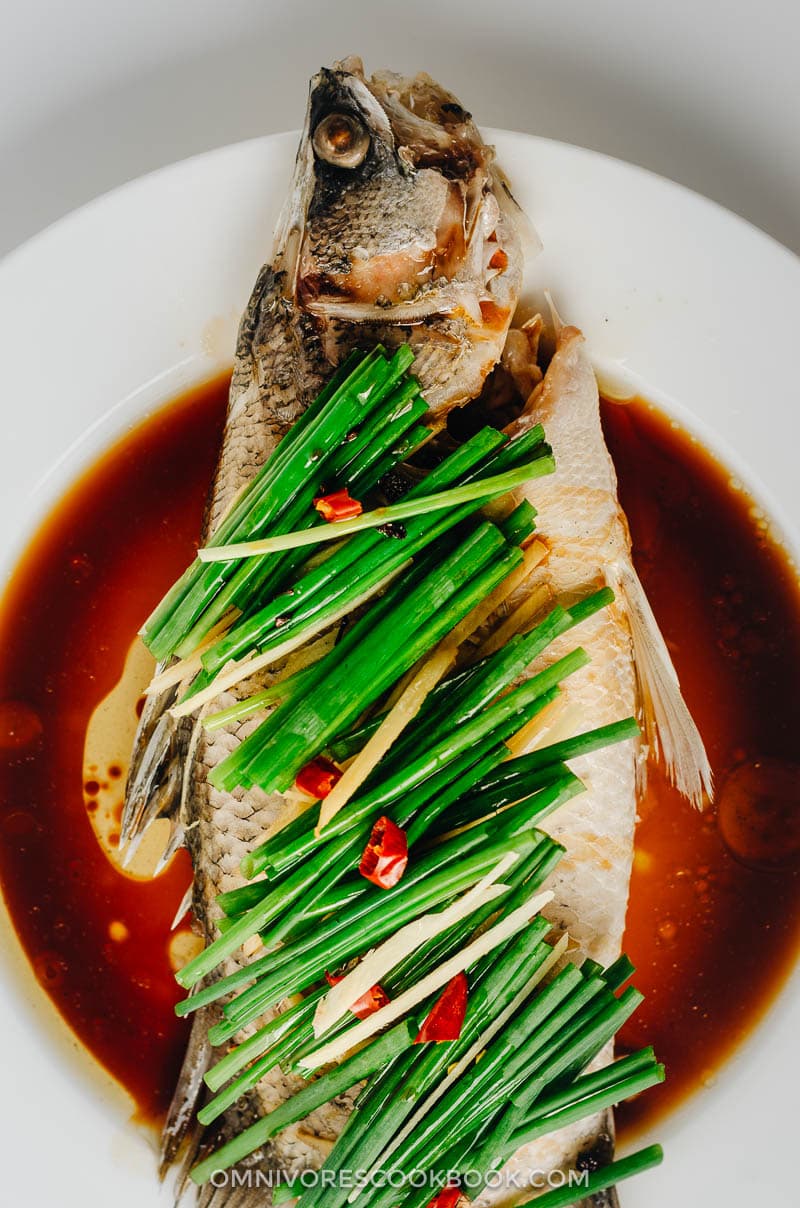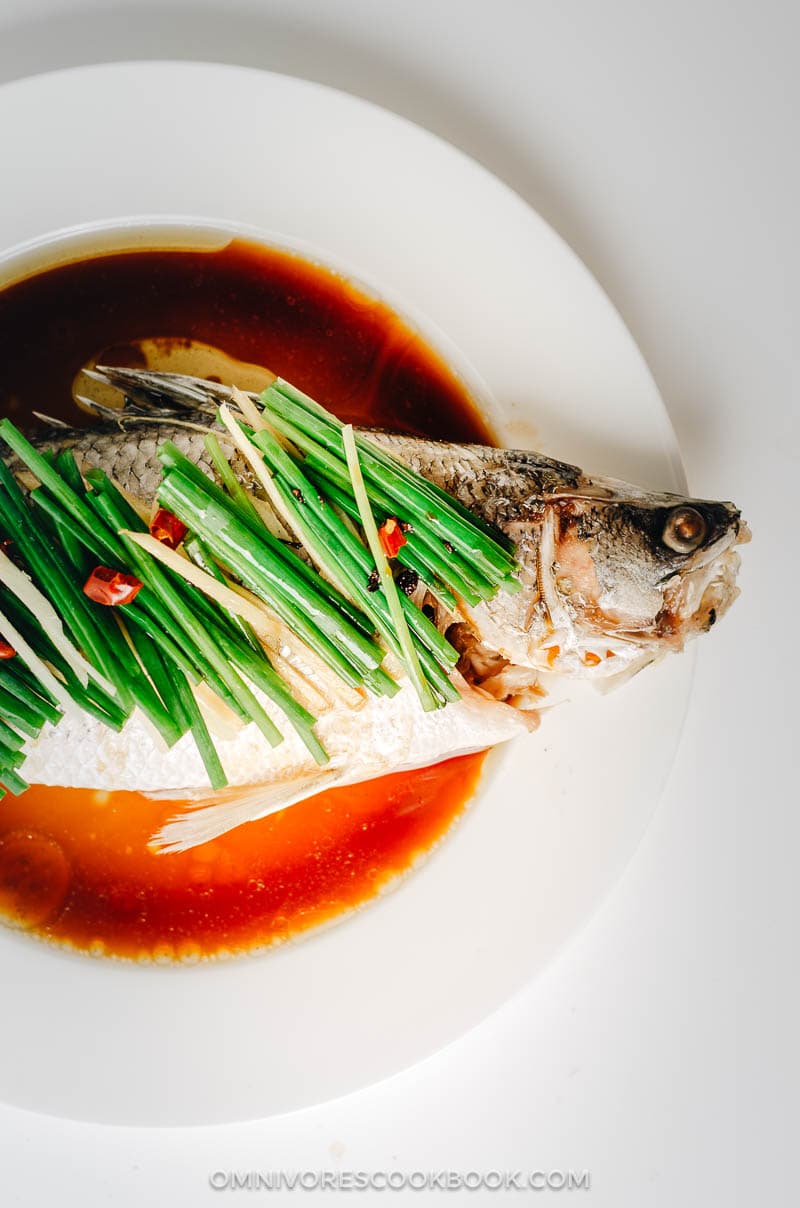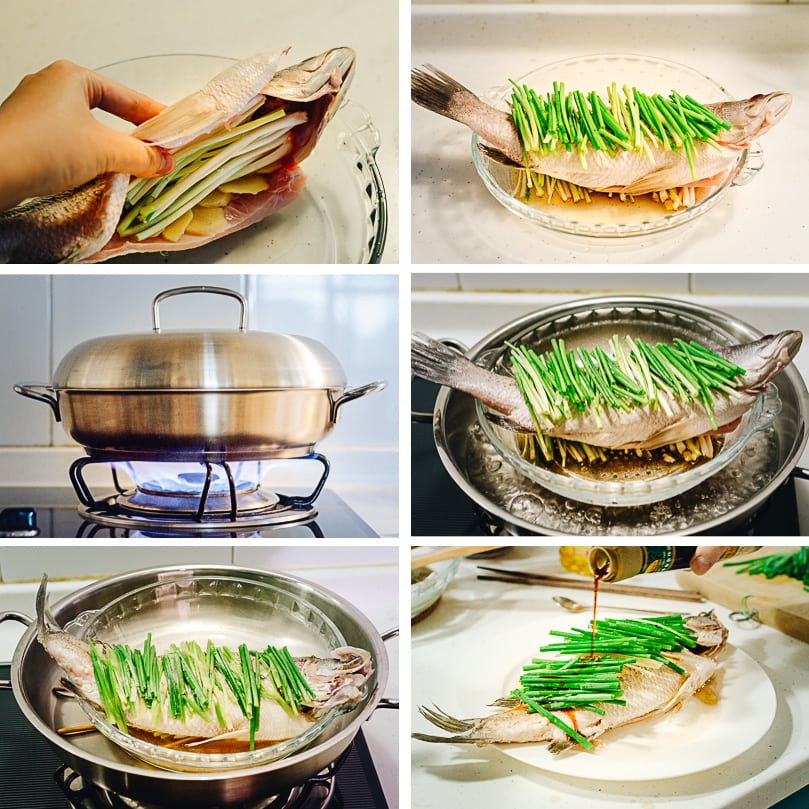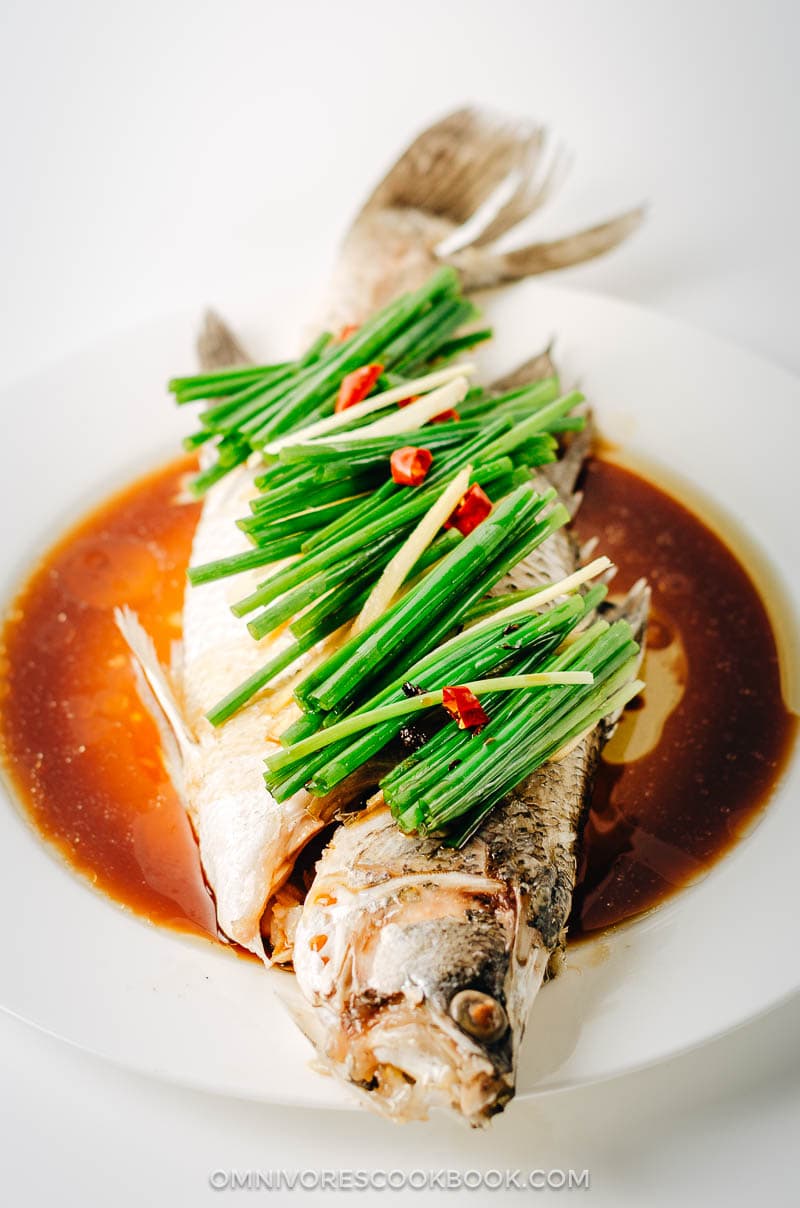Stuffed with ginger and green onions, the whole fish is steamed until flaky, tender, and juicy. It’s then quickly seared with an aromatic infused hot oil that makes the fish extra fragrant.

Steamed whole fish is a classic dish in Chinese home cooking. It uses very few ingredients to bring out the great flavor of fresh fish. The fresh ginger and green onion help eliminate any fishiness. The seasoned soy sauce adds a bit of sweet and savory umami to the dish. The fish is cooked with a steamer for the shortest amount of time, so that the finished meat is tender, silky and moist.
Steamed fish is also a dish that represents wealth and good fortune. In Chinese, the character for fish (鱼, yu) has the same pronunciation as that for “surplus” (余, yu), which indicates that a family has a surplus of wealth and food at the end of the year. For a lot of families, steamed fish is a must-have on the dinner table for Chinese New Year.

Although steamed fish is a very simple dish, it requires some techniques that make it stand out. If it is your first time cooking this dish, make sure to go through the list below, so you get all the important points.
The Secrets of Cooking Perfect Steamed Fish
(1) Select very fresh fish
Always choose a live fish if possible. If not, try to select a very fresh fish. If the fish is fresh, it will have clear eyes and metallic scales. It shouldn’t have a fishy or stinky smell.
(2) Select smaller and thinner fish
Try to select a fish that is around 550 grams (20 ounces). Do not select a fish that is heavier than 700 grams (25 ounces). This dish uses minimal seasoning and cooking. The bigger the fish, the tougher and thicker the flesh, which will result in a flaky, tough texture. Fish with thinner and flatter flesh work better, for example, flounder.
(2) Dry the fish thoroughly before cooking
You could place the fish in a colander at room temperature for an hour. If you want to speed up the process, slightly press both sides of the fish with a paper towel. It helps the flesh to tighten up a bit. The texture of the fish will be smoother and absorb flavor better after cooking.
(3) Do not overcook
When you start to steam the fish, It is very important to keep the heat as high as possible, so the fish will be cooked in the shortest amount of time.
A 550-gram (20-ounce) fish usually take 5 to 8 minutes to cook. Larger and thicker fish require more time, 8 to 10 minutes. Check the doneness of the fish after 5 minutes. If you can use a pair of chopsticks (or a fork) to remove the fish meat from the bone easily, then it’s cooked. Stop steaming immediately when the fish is just cooked through. If you use a thinner fish, such as flounder, you might need to shorten the cooking time.
(4) The correct way to season
After heating the oil, pour it onto the fish immediately, then add the seasoned soy sauce. The oil will cook the fish, as well as the soy sauce, so the flavors will blend well into the fish. Do not add seasoned soy sauce when you steam the fish. The flavor of the sauce will become bitter and its umami will disappear when heated.


To select side dishes that go with steamed fish, I prefer lighter ones like cucumber salad, potato strip salad or Chinese broccoli with oyster sauce. Or, you could go to the recipe index to browse for other choices. If you’re not familiar with Chinese ingredients, don’t forget to check out my pantry page. It lists some of the most common ingredients in Chinese cooking.

I hope you enjoy the dish and have a great week ahead!

Authentic Chinese Steamed Fish
Ingredients
- 550 grams (20 ounces) head-on sea bass (tilapia, flounder, or other fish with white flesh, scaled, gutted (*see footnote 1)
- 1 and 1/2 pieces thumb sized ginger ,1 thumb sliced, 1/2 thumb julienned (see footnote 2)
- 1 cup green onion , chopped (6 centimeters /2.5 inches in length)
- 2 tablespoons Shaoxing wine
- 1 teaspoon sesame oil
- 1 tablespoon peanut oil (or vegetable oil)
- 2 dried chili peppers
- 1/2 teaspoon Sichuan peppercorn
- 2 tablespoons seasoned soy sauce for seafood (or regular soy sauce)
Instructions
- Before cooking, wash the fish thoroughly and drain. Place the fish in a mesh colander at room temperature for 30 minutes to 1 hour, until completely dry. (Or dry by pressing the fish with a paper towel).
- Place a quarter of the green onions on a plate large enough to hold the entire fish. The green onions will hold the fish so it won’t stick to the plate when cooked.
- Stuff ginger slices and a quarter of the green onions (white part) into the cavity of the fish. Rub both sides of the fish with sesame oil. Cover the fish with another quarter of the green onions. Pour Shaoxing wine over the fish.
- In a large, deep skillet (or steamer or wok), add half an inch of water and place a steaming basket upside down (or heat resistant colander or strainer) in the middle (see footnote 3). Cover and bring water to a boil over high heat. Carefully place the plate holding the fish onto the steaming basket, cover and steam over high heat for 5 to 8 minutes, until you can easily pull the flesh from the bone with a fork. Stop heat immediately. Carefully use a spatula to transfer the fish to another large plate. Use chopsticks to remove the ginger and green onion from inside and above the fish, and discard the used ginger and onion.
- Spread the remaining ginger strips and green onions on top of the fish and set aside. Make sure the seasoned soy sauce is ready beside the fish.
- In a wok or small skillet, heat oil over medium high heat. When the oil is warm, break chili peppers and add them, with the Sichuan peppercorns, into the oil. Stir with a spatula until fragrant, about 40 seconds. Turn to lowest heat, carefully use a ladle to scoop out the chili pepper and peppercorn, and discard them. Immediately use a ladle to drizzle the hot oil over the fish. You should hear the sizzling of the oil when it touches the fish. Immediately pour the seasoned soy sauce onto the fish.
- Serve warm. The fish won’t hold sauce very well, so make sure you dip the fish meat into the sauce from the plate when eating. If the fish is not salty enough, you can add more seasoned soy sauce as you eat, according to your preference (see footnote 4).
Notes
- Before cooking, you should make sure you have a plate and a skillet (or a wok) that are large enough to hold the fish. If not, you should cut the fish in two such that each piece is half the original length, so it can fit into the skillet.
- In this recipe, I used quite a large amount of herbs because I wasn’t using a live fish. If you are using a live fish, you could reduce the ginger and green onion to two thirds the amount given here.
- If you don’t have steaming basket, you could place a pair of wooden chopstick, 4 inches apart, onto the bottom of a skillet as “feet” to hold the plate. You only need something to hold the plate off the bottom of the skillet and to make sure the water won’t spill onto the plate when steaming the fish.
- Although you could add the seasoned soy sauce afterwards, the flavor will taste slightly different from the way it tastes when poured immediately following the hot oil.
Nutrition
The nutrition facts are generated from 1 of the 2 servings generated from the recipe.














Hi Maggie, I love this way of preparing fish! It is my favourite way for whole fish. I love your blog! I can’t believe I haven’t come across you before 🙂 Subscribing now so I can make sure I don’t miss a post! I love finding great Asian blogs. Though my blog is not strictly Asian food, it is by far my favourite cuisine – every single country!
Ah, I looove steamed fish. My hubby doesn’t though, which is really frustrating because I don’t think I’ve eaten nearly as much as I used to after getting married! This recipe looks too delicious to pass up…will plan on making this when he is out of the house for a moment! 😉
This fish looks amazing and I really want to try it. Never had steamed fish before, but reading your instructions it seems pretty simple. Pinning!
Thanks Mira! The steamed is quite unique outside of China, but it’s so easy to make at home. Hope you enjoy the recipe 🙂
Wow, this is so beautifully photographed, and I love your attention to the details of the flavors! A very comprehensive guide 🙂
Thanks Sophie! It took me some time to figure out how to cook this dish to bring out the best flavor, so I shared the info. as thoroughly as I could! Glad you found it helpful! 🙂
Love this post Maggie! Steamed whole fish is one of my favorite dishes whenever we go out to a restaurant but I have never made it at home. This tutorial is awesome! Can’t wait to try making this 🙂 Pinning!
Thanks for sharing Kelly! This one is very easy to make, but you gonna get very fishy hands after dealing with the fish 😉 And yes, it’s one of my favorite too!
Maggie, I’m loving this dish! I’ve never made whole fish before, mostly because it’s so intimidating. What do you mean by “live fish”? One that’s alive right before you buy it? I can’t imagine actually taking home a live fish to prepare
Yes, by live fish I mean the ones that are alive right before you buy them. In China we usually let the butcher to clean up the fish before taking it home. But I know in rural area, or for people who really care about the freshness of the fish, they will bring a live fish home to gut it by themselves! I should try that one day and upload the slaughter to YouTube… Sorry if it sounds too bloody!
Hi There, What do you mean by seasoned soy sauce? Is this pe bought or do you make it up yourself from regular bought soy sauce? Love your site, truely inspiring., Thank you.
Hi Roger, it is a type of soy sauce I bought while I was still living in China. It is slightly sweet, designed for seasoning seafood.
If you don’t have it, you can use one part of regular soy sauce plus one part oyster sauce instead.
Great recipe, delicious and simple. I love the way the oil sizzled on the fish near the end. I used sea bream which worked well. I think next time I will use sea bass, a slightly thinner fish.
Hi Ernest, I’m glad to hear you like the recipe! Yes, a smaller and thinner fish always works better. A sea bass is perfect for cooking steamed fish 🙂
Another keeper, delicious and fun to make! I need to get better at getting the final sizzling thing with less oil though, I had to cheat a bit and use more 😉
Hi, my mom use to make steamed fish all the time. What fish do you usually get besides flounder that doesn’t have too much bones and great for steaming? This is my biggest dilemma even I’m at 99 Ranch. Is Goby a good option? Also my mom prepares it somewhat differently. She adds the soy sauce and other sauce to the hot oil and pour all together onto the fish. Does that impact the taste?
I used to date a guy who made fish this way, and it was AMAZING!! I’m so glad I found this recipe, so I can make this…. I miss it so much. I miss his cooking way more than the man himself, for sure.
I’m going to leave out the peppers, though; I’m a spice wuss. What could I substitute for the peppercorns and hot peppers in the oil? Maybe more ginger and a few lemon slices, or just straight-up, plain oil? I think that’s how he used to do it, to accommodate my sensitive, bland, white girl palate.
Thank you it tasted very good.
I have made this dish 3 times and including for a discerning cousin who was visiting. It is purely delicious and has greatly increased my appreciation for Chinese cooking techniques. Cant wait to make for a friend who’s an excellent cook!
Delicious!~Fantastic I served with jasmine rice and sauteed eggplant!
I really like this recipe. I would also recommend using honey and garlic with lemon and butter. I have cooked this dish today, it tastes perfect.